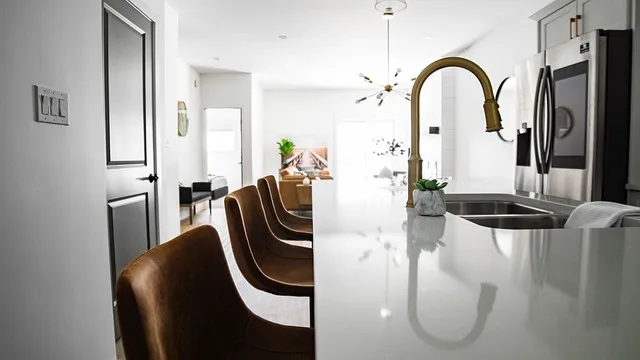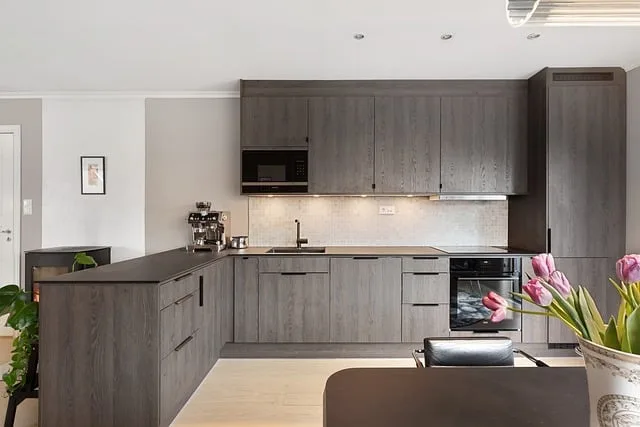First things first, you’ll want to gather your materials. Think of it as assembling your toolkit for a mini-makeover. You’ll need new veneer or laminate, adhesive, a utility knife, and some clamps. Don’t forget a measuring tape—trust me, you don’t want to end up with a cabinet door that’s too short or too long!
Next, it’s all about the prep work. Remove the cabinet doors and hardware, and give them a good clean. It’s like prepping a canvas before painting; you want a smooth surface to work with. Once everything’s clean, measure your doors and cut the veneer or laminate to size. This is where precision is key—like a chef slicing vegetables for a perfect stir-fry.
Now, apply the adhesive to the cabinet doors and carefully lay the veneer on top. Use clamps to hold everything in place while it dries. Think of it as giving your cabinets a cozy hug until they’re ready to shine. After the adhesive has set, trim any excess veneer with your utility knife for a clean finish.
Finally, reattach the hardware and hang those doors back up. Voilà! You’ve just transformed your kitchen with a little elbow grease and creativity. It’s amazing how a simple change can breathe new life into your space, making it feel fresh and inviting. So, are you ready to give your kitchen the facelift it deserves?
Transform Your Kitchen: A Step-by-Step Guide to Refacing Cabinet Doors
First things first, gather your supplies. You’ll need new veneer, adhesive, a utility knife, and some sandpaper. Think of this as your kitchen’s makeover kit! Once you’ve got everything, it’s time to remove those old cabinet doors. It’s like taking off a pair of old shoes that just don’t fit anymore. Unscrew the hinges and set the doors aside.
Next, prep the surfaces. This is where the magic begins! Sand down the old finish to create a smooth canvas. It’s like painting a masterpiece; you want a clean slate to work with. After sanding, wipe away the dust—nobody wants that ruining their new look!
Now, let’s talk about the fun part: applying the new veneer. Cut it to size and carefully adhere it to the cabinet doors. It’s like wrapping a gift; take your time to make it neat and tidy. Once it’s all in place, reattach the doors and step back to admire your handiwork.
Finally, don’t forget to add some new hardware! A shiny new handle can be the cherry on top of your kitchen transformation. It’s amazing how a few simple changes can breathe new life into your space. So, are you ready to roll up your sleeves and get started? Your dream kitchen is just a few steps away!
Revamp Your Space: The Ultimate DIY Guide to Refacing Kitchen Cabinets
First things first, let’s talk about the magic of refacing. Imagine giving your cabinets a fresh coat of paint or swapping out those old doors for something sleek and modern. It’s like giving your kitchen a facelift! You don’t need to be a professional carpenter; just a little creativity and some elbow grease will do the trick. Start by choosing a color that speaks to you—maybe a bold navy or a soft sage green. Paint can work wonders, and it’s a great way to express your personality.
Next, consider the hardware. Swapping out old knobs and handles for shiny new ones is like putting on a statement necklace. It instantly elevates the look! Plus, there are so many styles to choose from—vintage, modern, or even rustic. The right hardware can tie your whole kitchen together.
Now, let’s not forget about the insides. While you’re at it, why not organize those shelves? Use baskets or dividers to create a space that’s not just pretty but functional too. It’s like giving your kitchen a breath of fresh air!
So, are you ready to transform your kitchen? With a little imagination and some DIY spirit, you can create a space that feels brand new. Your dream kitchen is just a few steps away!
From Drab to Fab: How to Reface Your Kitchen Cabinet Doors Like a Pro
Imagine your kitchen as a blank canvas. Refacing is like giving it a fresh coat of paint, but with a twist! Instead of replacing the entire cabinet, you simply update the doors and drawer fronts. It’s like putting on a new outfit that makes you feel fabulous without the hassle of a complete wardrobe overhaul.

First things first, you’ll want to choose your materials wisely. Whether you’re leaning towards sleek laminate, rich wood veneers, or even a bold paint color, the options are endless. Think of it as picking the perfect accessories to elevate your look. Once you’ve settled on your style, it’s time to get to work!
Start by removing the old doors and hardware. This is where the fun begins! Sand down any rough spots and clean the surfaces thoroughly. It’s like prepping a canvas before painting—every detail matters. Next, apply your chosen veneer or paint. If you’re going for a painted look, consider using a sprayer for that smooth, professional finish.
Don’t forget about the hardware! New knobs and handles can make a world of difference, like the cherry on top of a sundae. Choose something that complements your new style, and watch your kitchen transform from drab to fab in no time.
So, are you ready to roll up your sleeves and give your kitchen a stunning makeover? Let’s get started!
Budget-Friendly Kitchen Makeover: Mastering the Art of Cabinet Door Refacing
Imagine this: instead of ripping out your old cabinets and spending a fortune on replacements, you simply update the doors. It’s like swapping out an old, worn-out jacket for a trendy new one. You keep the structure intact, but the look? Totally revamped! With a little creativity and some elbow grease, you can choose from a variety of styles, colors, and finishes that reflect your personality.
Now, you might be wondering, “Is this really worth it?” Absolutely! Refacing your cabinet doors can save you up to 50% compared to a full remodel. Plus, it’s a project you can tackle over a weekend. Just think of it as a fun DIY adventure! You’ll need some basic tools, a bit of patience, and a vision for what you want your kitchen to be.
Unlock Your Kitchen’s Potential: Expert Tips for Refacing Cabinet Doors
First off, let’s talk about materials. Choosing the right veneer is like picking the perfect outfit for a big night out. You want something that not only looks good but also stands the test of time. Opt for high-quality wood or laminate that complements your kitchen’s style. Think of it as giving your cabinets a stylish new wardrobe!
Next, don’t underestimate the power of color. A fresh coat of paint can work wonders. Picture your cabinets in a bold navy or a soft sage green—suddenly, your kitchen feels like a trendy café! And if you’re feeling adventurous, consider two-tone cabinets. It’s like having a little fun with your kitchen’s personality.
Now, let’s dive into hardware. Swapping out old knobs and handles is like adding the perfect accessories to an outfit. Choose modern, sleek designs for a contemporary look, or go vintage for a touch of charm. The right hardware can elevate your cabinets from ordinary to extraordinary.
Lastly, don’t forget about the finishing touches. Adding under-cabinet lighting can create a warm ambiance, making your kitchen feel inviting. It’s like setting the mood for a cozy dinner party!
Refacing Kitchen Cabinets: A Sustainable Solution for a Fresh Look
Refacing kitchen cabinets is not just a smart choice for your wallet; it’s also a sustainable solution that Mother Earth would approve of. Think about it: instead of sending your old cabinets to a landfill, you’re simply updating their look. It’s like putting a fresh coat of paint on a classic car—you’re preserving the good stuff while making it shine again. You can swap out the doors, add new hardware, and even change the finish. Suddenly, your kitchen transforms from drab to fab!

But wait, there’s more! Refacing is also a time-saver. You can often complete the project in just a few days, compared to weeks of chaos with a full renovation. Imagine enjoying your newly refreshed kitchen in no time, without the stress of contractors and dust everywhere. Plus, you get to choose from a variety of materials and styles, so you can create a look that’s uniquely yours.
Frequently Asked Questions
What is Kitchen Cabinet Door Refacing?
This process involves updating the appearance of kitchen cabinets by replacing or covering the existing doors and drawer fronts with new materials, while keeping the original cabinet structure intact. It enhances the kitchen’s aesthetic without the cost and effort of a full remodel.
How Long Does the Refacing Process Take?
The duration of the refacing process typically ranges from a few days to a couple of weeks, depending on the size of the project and the materials used. Factors such as the complexity of the design and the availability of resources can also influence the timeline.
Can I Reface My Cabinet Doors Myself?
Refacing cabinet doors yourself is possible and can be a cost-effective way to update your kitchen or bathroom. It involves removing the existing doors and applying a new veneer or paint. Ensure you have the right tools, materials, and a clear plan to achieve a professional-looking finish. Proper preparation and technique are key to a successful DIY project.
What Materials Do I Need for Refacing?
To successfully reface surfaces, you will need a variety of materials including veneer or laminate sheets, adhesive, a utility knife or saw for cutting, sandpaper for smoothing edges, and clamps for securing the materials during installation. Additionally, having a measuring tape, a level, and safety gear like gloves and goggles will ensure a safe and precise process.
How Do I Prepare for Cabinet Door Refacing?
To prepare for cabinet door refacing, start by removing all cabinet doors and hardware. Clean the surfaces thoroughly to eliminate grease and dirt. Measure the dimensions of the doors and frames accurately to ensure a proper fit for new materials. Choose your refacing materials, such as laminate or veneer, and gather necessary tools like a utility knife, adhesive, and clamps. Finally, ensure your workspace is organized and well-ventilated for a smooth refacing process.